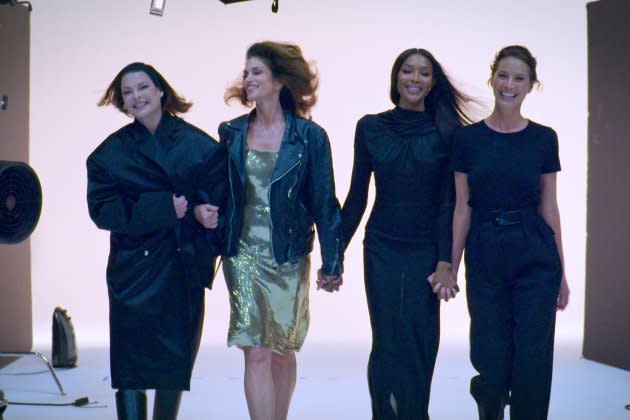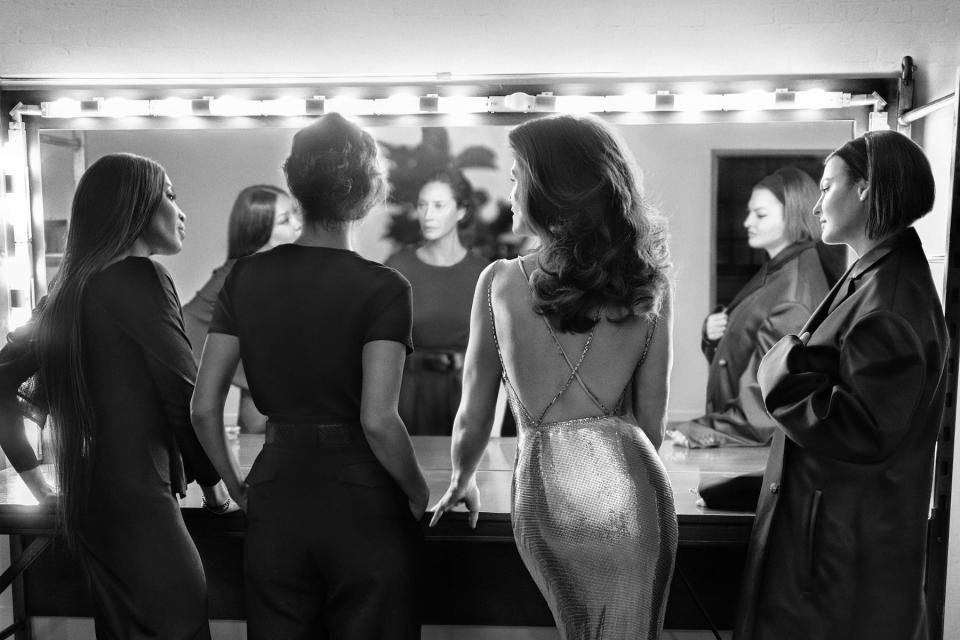‘The Super Models’ Directors Didn’t Want to ‘Make a Puff Piece’

You know their names: Naomi Campbell, Linda Evangelista, Cindy Crawford, and Christy Turlington. The supermodel quartet reached instant fame and held the fashion industry in the palm of their hands in the Nineties. To filmmaker Roger Ross Williams, they were the first influencers with indelible power, photographed globally and enamored by millions.
“They’d seen them in pictures,” Williams says to Rolling Stone, “but they hadn’t heard them speak.”
More from Rolling Stone
'Superpower' Is Sean Penn's Odd Vanity Project About Zelensky
Surviving DSW's 35% Off Sitewide Sale - Prepare to Empty Your Wallets
In the docuseries The Super Models, now streaming on Apple TV+, the fashion deities discuss their rise to stardom, their shatterproof bond, as well as the battles they faced in private. According to co-directors Williams and Larissa Bills, the four-part series is not intended to be a glamorous retelling of their lives but an opportunity for the women to reclaim their voices.
While filming at Highline Studios in Manhattan, each O.G. supermodel had a tent-sized dressing room with dozens of dresses, mounds of jewelry, and an endless shoe selection. Williams, overwhelmed by the glitz, questioned, “How do they decide what to wear?” The Emmy and Oscar-winning filmmaker found it exciting to see the foursome together, reflecting on the years that shaped their careers.
“It’s fashion and it’s fun and light, but also it’s life,” Williams says. “Fashion is life, and they all had very tough and emotional moments. It was important for both of us to tell that part of the story.”
When Williams and Bills grabbed dinner with Evangelista for the first time, Williams was initially intimidated by her prestige and power. But after learning that her dog, Mini Moon, had recently died, they all began to cry. As the night went on, he praised her for her influence on Black and queer culture, referencing FX’s Pose and the House of Evangelista, a fictional house inspired by the legendary model.
“It was a cry fest over our sauvignon blancs or martinis, I can’t remember,” Williams says.
The series highlights it all: their humble upbringings growing up behind the camera and their first Vogue covers – with Campbell becoming the first Black woman to grace a French Vogue cover in 1988. They break down the murder of Gianni Versace in his Miami Beach home, and the death of designer Azzedine Alaïa, who was a father figure to Campbell. Following the passing of her “chosen family,” Versace and Alaïa, Campbell opens up about her bouts of anger, addiction and going to rehab.
“When I started using, that was one of the things I tried to cover up, was grief,” she admits in the series.
As an executive producer on Hulu’s docuseries The 1619 Project, which traces the legacy of slavery, and director of Netflix’s Stamped from the Beginning, examining the origins of racism, Williams says he’s familiar with the racial stereotypes associated with Black women, who are historically sexualized and marginalized. In the series, Campbell notes, “it was hard to be an outspoken Black woman” and says she had been called “crazy,” “difficult,” and a “nightmare” to work with.
“Naomi, just speaking up for herself, just standing up for what she deserves and what her talent deserves, she gets accused of all these things, and that’s just pure racism,” Williams says.
Turlington reflects on staying in former model executive Jean-Luc Brunel’s apartment, who was accused of rape and questioned on suspicion of supplying underage girls to disgraced financier Jeffrey Epstein, and said most nights he wasn’t home. Brunel took his own life while behind bars last year.
The series also delves into the relationship between Evangelista and Elite Model Management executive Gérald Marie, with the supermodel suggesting the relationship was physically abusive.
“He knew not to touch my face, not to touch the moneymaker, you know?” she says in the docuseries.
Marie was accused of a number of alleged sexual assaults, but French prosecutors closed the investigation in February due to the country’s statute of limitations. Evangelista says she never shared her story out of fear and credited the women who spoke up for giving her the confidence. Marie’s lawyer says he denies claims of abuse, adding he “has never committed the slightest act of violence,” according to a statement in the docuseries.

For Evangelista, who overcame an unhealthy relationship, a CoolSculpting nightmare, and double mastectomy after getting cancer, Bills says she suffers from survivor’s guilt.
“These women were the one percent that did very, very well, but they did have their challenges,” Bills says. “Certainly, they were probably luckier than most, and I think they would say that.”
As supermodels with symmetrical features and slim figures, Bills admits to feeling skeptical about highlighting women that perpetuated such a narrow beauty standard. Vogue’s September issue featuring the four women received backlash for “egregious age erasing” and retouching of the supermodels. Despite this, Bills says the O.G.s helped elevate the profession and opened doors for models of different body types, races, and genders.
“Women could enjoy beauty, could be beautiful, could wear beautiful clothing, wear makeup, and they’re still considered a feminist,” Bills explains.
And of course, the series acknowledges Crawford’s iconic Pepsi campaign, how much Evangelista would not get out of bed for (that’s anything under $10k), and George Michael’s “Freedom! ‘90” music video that featured the four supermodels more than 30 years ago.
When filming the final scene of The Super Models, the women strutted to “Freedom! ‘90” as makeup artist Pat Mcgrath rapped over the mic while Williams instructed the supermodels how to walk. (As a New York University student, Williams worked in the VIP room at Manhattan’s Palladium nightclub and learned how to mimic each of their runway walks; Naomi’s walk was his favorite.)
By the end, Williams and Bills were both in tears.
“We never set out to make some light puff piece,” Bills says. “The reason why I wanted to do this is because I wanted the women to be able to tell their own stories, to own their own stories.”
Best of Rolling Stone


